![[Picture]](a.gif)
Adenium obesum Roem. & Schult.
Adenium obesum, as recognized here, occurs in two disjunct populations. One
occurs nearly all the way across Africa in a broad band south of the Sahara, from Senegal to Sudan and Kenya. Another population, supposedly of the same species, occurs in Tanzania, southern Kenya, and northern Mozambique. In any case, neither of these can properly be called A. obesum if one recognizes more than one species. That's because the type specimen of this species is from Aden on the Arabian peninsula. The plants we call A. arabicum are in fact the true A. obesum.
The most helpful identifier of this species is probably the petals that fade from darker on the margins to paler color toward the throat. If nectar guides are present in the throat, they are usually faint. The anther appendages rise to the edge of the throat or a little beyond. This is a potentially evergreen species that can flower at any time of year under tropical conditions. The caudexes range from poorly developed to substantial in different clones, but are never as massive as those of A. arabicum, somalense, or socotranum.
Adenium obesum has been highly selected in cultivation, yielding a wide range of colors from white to purple and dazzling reds, some with black suffusions. There are also bicolors and mutants with variegated flowers or leaves, leaves other than green, and various leaf shapes.
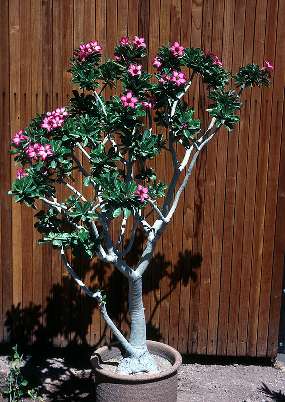
A typical wild type Adenium obesum. Notice the pink flowers and poor caudex. See flower below. |

A. obesum 'Red Everbloomer'. 4-year old cutting. Image below is its flower.
|
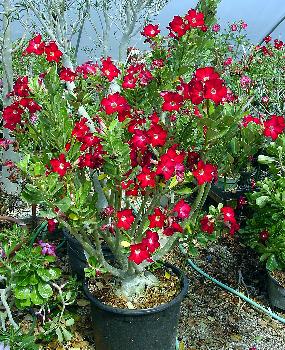
A. obesum 'Red Cloud'. The Taiwan strain of this species typically has large, shiny green leaves. There are many cultivars with superb red flowers. Flower closeup is below. |
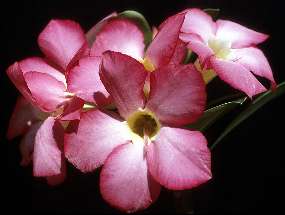
Flowers of a typical wild type A. obesum. Other colors are rare in the wild. Note the fading of petal color toward the throat in all of the images of this species.
|
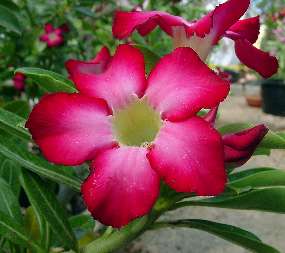
A. obesum 'Red Everbloomer'. When it first flowered in 1980, it was an excellent and exciting new color. Today it would be tossed into the trash. This is how far adenium breeding has come in 25 years.
|
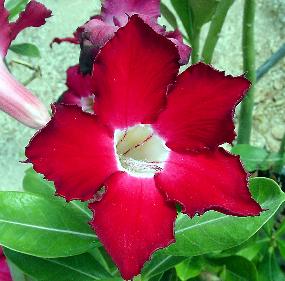
A. obesum 'Red Cloud'. This was the best plant from 1000 seeds imported from Taiwan in 1999. See plant above. |
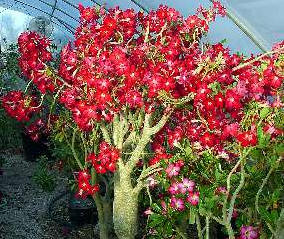
A. obesum 'Black Ruby'. This clone flowers profusely and develops a tall, conical caudex; this plant is a 7 year old graft (rootstock has been cropped off image). It appears to be of the Taiwan Red strain, but it is more cold tolerant than most of those plants bred in the tropics.
|

Flower of 'Black Ruby'. This cultivar was discovered in the early 1990s in a Florida nursery by Jim Georgusis. Beyond that its origin is unknown. The flower quality has been surpassed by numerous Taiwan selections, but this is still a great plant because of its substantial caudex.. |
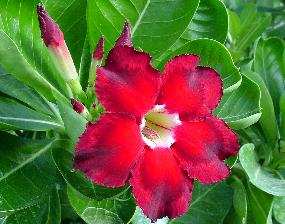
A. obesum 'Incandescent'. This is an offspring of 'Black Ruby' X 'MAD 218', bred by Dimmitt.. |
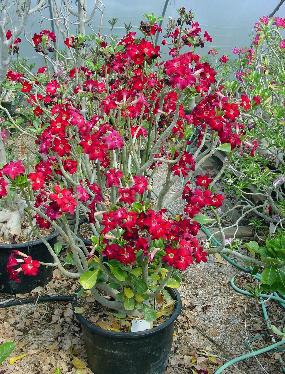
A. obesum 'Incandescent' flowers profusely nearly year-round. |
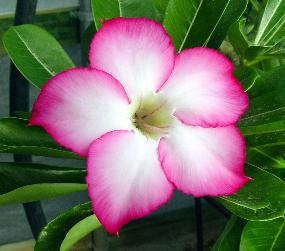
A. obesum, a good unnamed pink bred by Ashish Hansoti. |

A. obesum 'MAD #286', a pink picotee with yellow throat bred by Dimmitt from Ashish Hansoti stock. |
(click on thumbnail for full size picture)

![[Picture]](a.gif)












